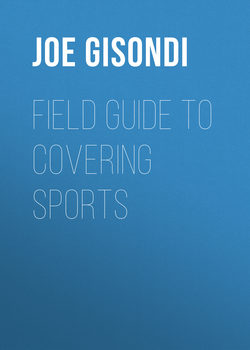Читать книгу Field Guide to Covering Sports - Joe Gisondi - Страница 43
На сайте Литреса книга снята с продажи.
Observe
ОглавлениеOnce you’ve determined the main characters in your story, look for the main places where significant scenes are likely to happen. To gain a different perspective, visit places away from the playing fields, such as a player’s old high school, a river where a rower trains, or a coach’s home or office. What’s on the walls of the coach’s office? What does the high school basketball gym smell like? Whom does a player pal around with away from the field? Or perhaps you travel to a town in Texas to learn more about an NFL player’s roots, walking through town, chatting with residents, and absorbing the sights and sounds:
“Tomlinson Hill is not listed on maps. Locals refer to it as a settlement, not a town. It does not have a post office, a gas station or a store. It is not really even a hill; the altitude rises slightly from nearby Marlin and Lott. Cows graze on either side of dirt roads. Dogs run unleashed in the streets. Their barking pierces the country quiet.”2
Or maybe you are invited to dinner with a major league baseball manager you are profiling, watching him make venison burgers and collard greens. You pause and take note of the moment: the sun slanting through the window and filling a window-lined nook. As you eat, you notice a curious picture that hangs behind this person’s head, seemingly out of place in his home décor, so you ask about the black-and-white photo showing the darkest scene from the movie It’s a Wonderful Life: Jimmy Stewart’s character, George Bailey, about to jump from a bridge to his death. The manager responds with a story about suicide you had never expected:
“His whole world was upside down,” Baker says softly. “I’ve been there. I know what it’s like to lose hope.”
The words come haltingly. “There was a time, at a down moment, I was tired of it all,” he says, pausing. “Man, some of this stuff I’ve been holding on to for 20 years.”3
Your keen observations can lead to new and fresh angles, such as the one above. Fill your notebook with these specific details about places, people, and things you might need during the writing process.
In addition, listen for conversations that help define moments, illustrate points, or drive plot lines. You might also reconstruct dialogue through research and interviews, asking multiple sources to describe a moment where they talked with one another. You can insert the conversation within quote marks, as Jeremy Markovich does in his story on Dick Trickle’s suicide, entitled “Elegy of a Race Car Driver,” especially if you can confirm the information through documents, video or 911 audio:
Sometime after 10:30 on a Thursday morning in May, after he’d had his cup of coffee, Dick Trickle snuck out of the house. His wife didn’t see him go. He eased his 20-year-old Ford pickup out on the road and headed toward Boger City, N.C., 10 minutes away. He drove down Highway 150, a two-lane road that cuts through farm fields and stands of trees and humble country homes that dot the Piedmont west of Charlotte, just outside the reach of its suburban sprawl. Trickle pulled into a graveyard across the street from a Citgo station. He drove around to the back. It was sunny. The wind blew gently from the west. Just after noon, he dialed 911. The dispatcher asked for his address.
“Uh, the Forest Lawn, uh, Cemetery on 150,” he said, his voice calm. The dispatcher asked for his name. He didn’t give it.
“On the backside of it, on the back by a ’93 pickup, there’s gonna be a dead body,” he said.
“OK,” the woman said, deadpan.
“Suicide,” he said. “Suicide.”
“Are you there?”
“I’m the one.”
“OK, listen to me, sir, listen to me.”
“Yes, it’ll be 150, Forest Lawn Cemetery, in the back by a Ford pickup.”
“OK, sir, sir, let me get some help to you.”
Click.4
Or you can present dialogue in other formats, informing your audience when you cannot verify the exact dialogue, as Kurt Streeter did in his piece on a young female boxer entitled “The Girl.” He puts dialogue he did not hear himself in italics, including the conversation cited in the opening paragraphs below:
Do girls box? she asked, turning to her father one evening. Is it OK for girls to box?
Well, yeah, mija, they do, he answered. Sure, it’s OK for girls to box.
They were sitting on the bed in his cramped apartment, faces lit by a flickering TV, eating pizza, watching a pro boxing match. Seniesa loved to watch fights with him, loved the way boxers settled their differences, using fists to express what was inside. She was just a kid, a girl enthralled with a man’s sport, but she wanted to express herself like that.
Dad? Can I box? Can I learn how to box? 5
Access is a challenge at many levels, especially for those covering professional or major-college sports programs. But you can still gain a great deal of access to athletes competing in minor sports at major colleges, to athletes at major sports at smaller colleges, and to high school and amateur athletes. Often, the best feature stories are found off the beaten path, away from these major programs. Just check any annual edition of the Best American Sports Writing series that features stories on hunting for elephants in Botswana, on a Hall of Fame football player battling Alzheimer’s, on the world’s best squatter, and on a cave explorer. Step away from the spotlight to find unreported stories worth investigating.
If you do profile someone, hang out as much as possible—watch practices, attend meetings, follow the person across campus, go to lunch together. Observe and take some notes, even if you can only do so mentally.
